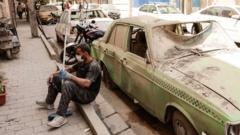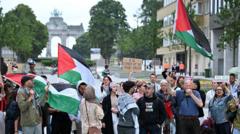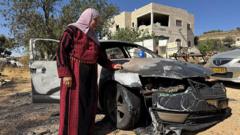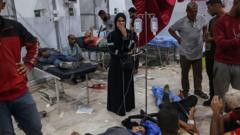Following the implementation of a US-backed aid distribution system, at least 500 Palestinians have reportedly been killed amid ongoing gunfire and disorder. Witnesses and health officials attribute many of these casualties to Israeli fire, raising serious concerns about the militarization of humanitarian efforts in the region.
Chaos and Gunfire Mark One Month of Controversial Aid System in Gaza

Chaos and Gunfire Mark One Month of Controversial Aid System in Gaza
Recent reports depict a fraught scene in Gaza with new aid distribution methods plagued by violence and chaos.
A month since the introduction of a contentious aid distribution system in Gaza, the atmosphere surrounding aid collection remains intensely perilous, marked by persistent gunfire and a sense of chaos. Analysis conducted by BBC Verify discloses numerous incidents where gunfire erupted while people attempted to gather essential supplies. The Hamas-run health ministry reports that over 500 individuals have died and approximately 4,000 have been injured in this timeframe, with accusations directed toward Israeli forces by both health officials and eyewitnesses.
Despite the gravity of the situation, BBC Verify has been unable to definitively identify the primary source of the violence. The Israel Defense Forces (IDF) assert that any gunfire came as a result of warning shots targeted at individuals perceived as threats. They charge Hamas with obstructing aid efforts, arguing that the group's actions further endanger the lives of Gazan citizens.
The background of this unrest began with Israel’s announcement on May 18 to partially lift an extended blockade, aimed at prompting Hamas to release hostages. Subsequently, the IDF established four aid distribution centers, under strict military oversight, but faced swift international condemnation for fostering a path to aid that significantly compromises civilian safety.
The humanitarian situation has deteriorated rapidly. Each passing day has seen new reports of violence against those seeking assistance. The UN and other humanitarian agencies continue to advocate for aid, stressing their reliance on Israeli facilitation for operations.
Notably, the International Red Cross disclosed that its Rafah field hospital had activated mass casualty protocols multiple times since the new system began due to overwhelming incidents of gunshot wounds among those visiting aid sites. The UN expressed that such killings could amount to war crimes, should evidence point toward intentional targeting of civilians.
Video footage captured throughout June revealed harrowing scenes of panic as people, attempting to secure aid, encountered bursts of automatic gunfire. Experts analyzing this footage suggest the sounds come from weapons commonly associated with both the IDF and Hamas, further complicating accountability.
Documents from the Gaza Humanitarian Foundation (GHF), which oversees assistance distribution, attempt to outline designated "safe" routes for civilians. Yet, eyewitness accounts indicate that many of these routes lack adequate protection, with fatalities occurring near different aid locations.
On June 17, a particularly tragic incident involved mass casualties when a crowd collected near an aid truck came under fire from IDF drones and tanks, resulting in numerous deaths. The IDF issued a limited acknowledgment of harm caused to civilians, although they defended the appropriateness of their military responses.
As the GHF contemplates its initial month of operations, claiming advancements in meal distribution to millions, they emphasize the need for additional humanitarian aid to alleviate the dire situation, denying reports attributing casualties to their initiatives. The Israeli military announced steps to enhance safety for aid seekers amid growing criticism regarding the prioritization of security measures over civilian welfare.
With escalating tensions and violence surrounding aid access, the plight of Gazans remains critically vulnerable, prompting calls for a reevaluation of the ongoing strategies involved in delivering humanitarian aid.




















